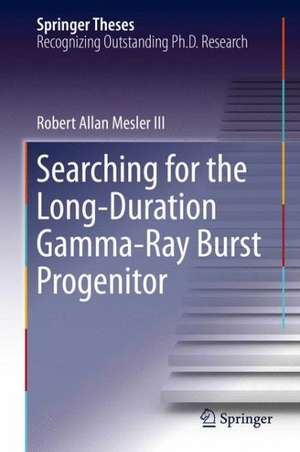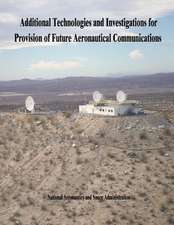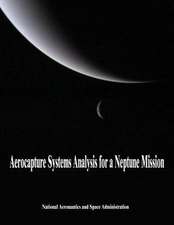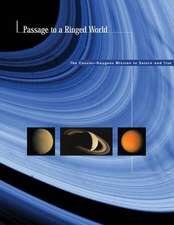Searching for the Long-Duration Gamma-Ray Burst Progenitor: Springer Theses
Autor Robert Allan Mesler IIIen Limba Engleză Hardback – 16 iul 2014
In this book, the author uses the Zeus-MP astrophysical hydrodynamics code to model the environment around a stellar progenitor prior to the burst. He then develops a new semi-analytic MHD and emission model to produce light curves for GRBs encountering these realistic density profiles. The work ultimately shows that the circumburst medium surrounding a GRB at the time of the explosion is much more complex than a pure wind, and that observed afterglows are entirely consistent with a large subset of proposed stellar progenitors.
| Toate formatele și edițiile | Preț | Express |
|---|---|---|
| Paperback (1) | 378.54 lei 6-8 săpt. | |
| Springer International Publishing – 23 aug 2016 | 378.54 lei 6-8 săpt. | |
| Hardback (1) | 387.75 lei 6-8 săpt. | |
| Springer International Publishing – 16 iul 2014 | 387.75 lei 6-8 săpt. |
Din seria Springer Theses
- 18%
 Preț: 997.88 lei
Preț: 997.88 lei -
 Preț: 389.88 lei
Preț: 389.88 lei - 15%
 Preț: 646.94 lei
Preț: 646.94 lei - 18%
 Preț: 943.43 lei
Preț: 943.43 lei -
 Preț: 399.29 lei
Preț: 399.29 lei - 18%
 Preț: 944.99 lei
Preț: 944.99 lei - 15%
 Preț: 636.80 lei
Preț: 636.80 lei - 18%
 Preț: 941.05 lei
Preț: 941.05 lei - 15%
 Preț: 643.16 lei
Preț: 643.16 lei - 15%
 Preț: 642.68 lei
Preț: 642.68 lei - 18%
 Preț: 1103.62 lei
Preț: 1103.62 lei - 20%
 Preț: 558.83 lei
Preț: 558.83 lei - 18%
 Preț: 1112.30 lei
Preț: 1112.30 lei - 18%
 Preț: 944.19 lei
Preț: 944.19 lei - 18%
 Preț: 1109.92 lei
Preț: 1109.92 lei - 18%
 Preț: 1217.27 lei
Preț: 1217.27 lei - 15%
 Preț: 640.06 lei
Preț: 640.06 lei - 15%
 Preț: 636.45 lei
Preț: 636.45 lei - 15%
 Preț: 640.06 lei
Preț: 640.06 lei - 15%
 Preț: 640.88 lei
Preț: 640.88 lei -
 Preț: 389.70 lei
Preț: 389.70 lei - 20%
 Preț: 563.91 lei
Preț: 563.91 lei -
 Preț: 393.35 lei
Preț: 393.35 lei - 15%
 Preț: 637.93 lei
Preț: 637.93 lei - 15%
 Preț: 641.85 lei
Preț: 641.85 lei - 18%
 Preț: 1225.94 lei
Preț: 1225.94 lei - 20%
 Preț: 551.36 lei
Preț: 551.36 lei - 18%
 Preț: 1229.10 lei
Preț: 1229.10 lei - 15%
 Preț: 639.25 lei
Preț: 639.25 lei - 18%
 Preț: 999.45 lei
Preț: 999.45 lei - 15%
 Preț: 640.06 lei
Preț: 640.06 lei - 18%
 Preț: 1220.45 lei
Preț: 1220.45 lei - 18%
 Preț: 1116.26 lei
Preț: 1116.26 lei - 18%
 Preț: 1110.72 lei
Preț: 1110.72 lei - 18%
 Preț: 1000.87 lei
Preț: 1000.87 lei - 18%
 Preț: 891.17 lei
Preț: 891.17 lei - 15%
 Preț: 640.06 lei
Preț: 640.06 lei - 5%
 Preț: 1154.07 lei
Preț: 1154.07 lei - 15%
 Preț: 635.96 lei
Preț: 635.96 lei - 15%
 Preț: 640.88 lei
Preț: 640.88 lei -
 Preț: 387.20 lei
Preț: 387.20 lei - 18%
 Preț: 1109.92 lei
Preț: 1109.92 lei -
 Preț: 385.25 lei
Preț: 385.25 lei -
 Preț: 385.25 lei
Preț: 385.25 lei - 18%
 Preț: 1112.30 lei
Preț: 1112.30 lei - 18%
 Preț: 999.45 lei
Preț: 999.45 lei -
 Preț: 386.99 lei
Preț: 386.99 lei - 15%
 Preț: 637.13 lei
Preț: 637.13 lei - 20%
 Preț: 554.21 lei
Preț: 554.21 lei - 20%
 Preț: 555.59 lei
Preț: 555.59 lei
Preț: 387.75 lei
Nou
Puncte Express: 582
Preț estimativ în valută:
74.20€ • 80.58$ • 62.33£
74.20€ • 80.58$ • 62.33£
Carte tipărită la comandă
Livrare economică 23 aprilie-07 mai
Preluare comenzi: 021 569.72.76
Specificații
ISBN-13: 9783319066257
ISBN-10: 3319066250
Pagini: 128
Ilustrații: XIII, 111 p. 25 illus., 21 illus. in color.
Dimensiuni: 155 x 235 x 13 mm
Greutate: 0.41 kg
Ediția:2014
Editura: Springer International Publishing
Colecția Springer
Seria Springer Theses
Locul publicării:Cham, Switzerland
ISBN-10: 3319066250
Pagini: 128
Ilustrații: XIII, 111 p. 25 illus., 21 illus. in color.
Dimensiuni: 155 x 235 x 13 mm
Greutate: 0.41 kg
Ediția:2014
Editura: Springer International Publishing
Colecția Springer
Seria Springer Theses
Locul publicării:Cham, Switzerland
Public țintă
ResearchCuprins
Introduction.- Gamma-ray Bursts in Circumstellar Shells.- Population III Gamma-ray Bursts.- VLBI and Archival VLA and WSRT Observations of GRB 030329.- Calorimetry of GRB 030329.- Conclusions.- Appendices.
Notă biografică
Robert Mesler obtained his BS in physics, with minors in math and astronomy, from James Madison University in Virginia. While at JMU, he co-founded the JMU Astronomy Club. He also participated in a summer REU program at East Tennessee State University, where he performed differential photometry on Post-AGB stars and did a little work with the 0.9 meter SARA telescope at Kitt Peak, looking for optical GRB afterglows. After graduation, Mesler was accepted to the University of New Mexico’s Physics and Astronomy graduate program, and he obtained his MS in physics in 2011. At UNM, he has worked on a variety of projects, including the DRIFT dark matter instrument, particle air shower theory, and detection of OH masers in the galactic center. He has co-authored seven papers, four of which he is the lead author. Mesler will be defending his PhD in October 2013.
Textul de pe ultima copertă
Nominated as an outstanding thesis by the Department of Physics and Astronomy of the University of New Mexico, this thesis seeks to identify the gamma-ray burst (GRB) progenitor. GRBs are extragalactic explosions that briefly outshine entire galaxies, but the mechanism that can release that much energy over a < 100 second burst is still a mystery. The leading candidate for the GRB progenitor is currently a massive star which collapses to form a black hole–accretion disk system that powers the GRB. GRB afterglows, however, do not always show the expected behavior of a relativistic blast wave interacting with the stellar wind that such a progenitor should have produced before its collapse.
In this book, the author uses the Zeus-MP astrophysical hydrodynamics code to model the environment around a stellar progenitor prior to the burst. He then develops a new semi-analytic MHD and emission model to produce light curves for GRBs encountering these realistic density profiles. The work ultimately shows that the circumburst medium surrounding a GRB at the time of the explosion is much more complex than a pure wind, and that observed afterglows are entirely consistent with a large subset of proposed stellar progenitors.
In this book, the author uses the Zeus-MP astrophysical hydrodynamics code to model the environment around a stellar progenitor prior to the burst. He then develops a new semi-analytic MHD and emission model to produce light curves for GRBs encountering these realistic density profiles. The work ultimately shows that the circumburst medium surrounding a GRB at the time of the explosion is much more complex than a pure wind, and that observed afterglows are entirely consistent with a large subset of proposed stellar progenitors.
Caracteristici
Nominated as an outstanding thesis by the Department of Physics and Astronomy of the University of New Mexico Derives a powerful new semi-analytic GRB jet hydrodynamics and afterglow emissions model, which is uniquely capable of handling jet evolution in our realistic density profiles Presents evidence that realistic circumburst environments are produced, which show that the standard model for such environments is a serious oversimplification Includes supplementary material: sn.pub/extras


























